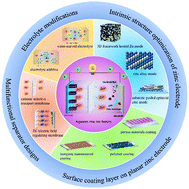Challenges in the material and structural design of zinc anode towards high-performance aqueous zinc-ion batteries
Abstract
Rechargeable aqueous metal-ion batteries are very promising as alternative energy storage devices during the post-lithium-ion era because of their green and safe inherent features. Among the different aqueous metal-ion batteries, aqueous zinc-ion batteries (ZIBs) have recently been studied extensively due to their unique and outstanding benefits that hold promise for large-scale power storage systems. However, zinc anode problems in ZIBs, such as zinc dendrites and side reactions, severely shorten the ZIB's cycle lifetime, thus restricting their practical application. Here, we sum up in detail the recent progress on general strategies to suppress zinc dendrites and zinc anode side reactions based on advanced materials and structure design, including the modification of the planar zinc electrode surface layer, internal structural optimization of the zinc bulk electrode, modification of the electrolyte and construction of the multifunctional separator. The various functional materials, structures and battery efficiencies are discussed. Finally, the challenges for ZIBs are identified in the production of functional zinc anodes.



 Please wait while we load your content...
Please wait while we load your content...